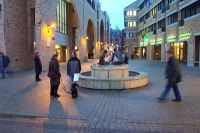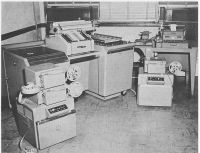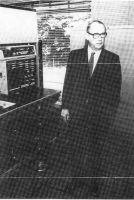Close Encounter of the Third Kind with a Trained-by-Fun 'Informaticien'
 A week or so ago, I went to Louvain-la-Neuve catching up with my readings on the economics of technology, especially the writing by Nathan Rosenberg on technological pathways and Tissot and Veyrassat's interesting edited volume on technological trajectories. The trip was also the occasion to visit Gilbert Lemaître, nephew of Georges Lemaître, and also one of the pioneers contributing to our research on Belgian Computing History with
A week or so ago, I went to Louvain-la-Neuve catching up with my readings on the economics of technology, especially the writing by Nathan Rosenberg on technological pathways and Tissot and Veyrassat's interesting edited volume on technological trajectories. The trip was also the occasion to visit Gilbert Lemaître, nephew of Georges Lemaître, and also one of the pioneers contributing to our research on Belgian Computing History with  Marie d'Udekem-Gevers here at the FUNDP. As per usual while meeting pioneers, this trip turned up into some sort of strange close encounter of the third kind, the third kind of self-learnt always-on-the-move computer people that barely do not exist any more.
Marie d'Udekem-Gevers here at the FUNDP. As per usual while meeting pioneers, this trip turned up into some sort of strange close encounter of the third kind, the third kind of self-learnt always-on-the-move computer people that barely do not exist any more.
As I have mentioned, Gilbert Lemaître is Georges Lemaître's nephew, Georges Lemaître being the astronomer and mathematician who was the topic of my undergraduate dissertation and about whom I have mentioned the love for old-fashioned calculators and the passion for numerical calculational methods. Gilbert Lemaître finished his studies during the 1960s. Then he went to work to the Centre d'Etudes Atomiques et Nucléaires of Mol, a centre in nuclear physics located in Flanders, near Antwerp. He also worked with his uncle, especially at the design of local plotters for the local NCR-Elliott 802. Thereby Gilbert was also led to get involved very closely with modern developments in computing. Previously to his passage in Mol, he had had his uncle Georges Lemaître  instructing him to automatic computing machineries, among others the Burroughs E 101 he had at his laboratory during 1958-1962, leading to skills he perfected with the NCR-Elliott 802 that succeeded it. At Mol, he met a Ferranti Mercury, and a few years later, he was working at the Bureau d'Etudes Ordinateurs, a spin-off from the Laboratoire de Recherches MBLE created in 1963 by Vitold Belevitch. His later career took place at the Université Catholique de Louvain, where he was among the firsts to get the grade of 'informaticien'.
instructing him to automatic computing machineries, among others the Burroughs E 101 he had at his laboratory during 1958-1962, leading to skills he perfected with the NCR-Elliott 802 that succeeded it. At Mol, he met a Ferranti Mercury, and a few years later, he was working at the Bureau d'Etudes Ordinateurs, a spin-off from the Laboratoire de Recherches MBLE created in 1963 by Vitold Belevitch. His later career took place at the Université Catholique de Louvain, where he was among the firsts to get the grade of 'informaticien'.
Until here, nothing really odd or unusual about the encounter you will say ... The unusual is coming from the actual little nitty gritty details of the meeting. Like many early days computer experts and researchers, Gilbert Lemaître was one of these pioneers who were not told on their first days what their job of everyday was actually going to look like. While working with his uncle on the Burroughs 101 and the NCR-Elliott 802 he was to be led towards discovering the joys of programming on machines sometimes, if not often, ill-equipped. In particular the Burroughs was quite some characterial piece with its pin-board programming area. The NCR-Elliott 802 proved no easier. The firm came out with its own Autocode. Yet local requirements by users soon called in for some intervention at the programming level, and Gilbert Lemaître came out with an adaptation of its own, the Vélocode, nicknamed so because it was faster, and much more efficient, provided you were ready to learn the language; and then you could then play with tens of meters long paper tapes. 'Funny' practices did not stop at that. Habits were to listen to the 802 to spot its misbehaviours, and also to get it to 'sing' some funny students' songs such as the "Chant des Wallons" (a bit like when the Manchester Mark I 'sang' the "God Save the Queen"). Home-made plotting instruments were to be first first tested with ... a smurf. There was some fun on out there thus, and, also advanced scientific work too, with physicists managing pseudo-Monte Carlo simulations on machines barely equipped for transcendental functions.
What the meeting also reminded me of was how early pioneers in computing had no background to locate themselves in a priori... There were little if no curriculum to get in; there were very few preprepared notes and advices to follow on while at doing their job as computing people; programming as foreseen by the computer firm very rarely corresponded to the actual practices that were needed to render the machine useful... As Knuth put it out rightly, computing was about practising a complex 'art'. These habits are hard-skinned. Gilbert Lemaître, in this dying age of 100s of Gb storage systems, still pulls up with playing at programming carefully and condensely in languages long forgotten, maybe not the PL-1, but the APL for sure, which he explains to you in details for hours alongside some fantastic comments on how his work on APL is informed and shaped by his practice of letting himself learn, a bit like the  process of learning as life attitude as it is discussed by Frank Herbert in Dune. Back to my place that night, I had the impression to have time-travelled; the meeting had taken place in a modern house with modern furniture and art pieces on the wall and yet it had been as much surreal as it could, filled with oddities, even for my young ears habituated to computer antics... Computers as artefacts are one thing, I agree on that; yet I cannot help joining in with Mike Mahoney's comment that the practices of computing ought to be looked at as about people as much as about machines, actually a process of negotiation between machines and practitioners, "both among practitioners about the nature of their practice and between practitioners and the realities of current technologies, often in the shape of non-practioner technicians."
process of learning as life attitude as it is discussed by Frank Herbert in Dune. Back to my place that night, I had the impression to have time-travelled; the meeting had taken place in a modern house with modern furniture and art pieces on the wall and yet it had been as much surreal as it could, filled with oddities, even for my young ears habituated to computer antics... Computers as artefacts are one thing, I agree on that; yet I cannot help joining in with Mike Mahoney's comment that the practices of computing ought to be looked at as about people as much as about machines, actually a process of negotiation between machines and practitioners, "both among practitioners about the nature of their practice and between practitioners and the realities of current technologies, often in the shape of non-practioner technicians."


